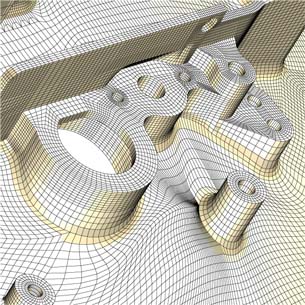TrueGrid AutoHex
XYZ Scientific Applications, Inc. has embarked on a three year program to build a truly automatic general purpose hexahedral mesh generator.
Latest News
May 25, 2010
By DE Editors
 |
In the past, a scientist or engineer had two choices when constructing a mesh for a computer simulation: hexahedral or tetrahedral meshes. The hexahedral mesh was more accurate but it took longer to build. Tetrahedral element meshes were just the opposite - they are quickly constructed, but they produce inaccurate results. Also in contrast with tetrahedral element meshes is the beauty of hexahedral element meshes. And this beauty can be quantified and correlated with higher accuracy. Scientists or engineers commonly make the extra effort to build a beautiful hexahedral mesh because the resulting simulation will be used as part of a report or presentation to others.
For those areas of research and design where a computer simulation must be reliable, hexahedral meshes are usually required. This is true when modeling non-linear events and especially with contact surfaces. It is also the case that hexahedral elements are needed wherever radioactive materials are involved. Hexahedral elements are ideal for computational fluid dynamics and especially when a boundary layer is involved. Hexahedral elements’ higher accuracy means that when a hexahedral element mesh is used, the resulting simulation will approximate the actual event more accurately than if a tetrahedron element mesh with the same element density were used. In some cases, such as a fluids calculation that requires a boundary layer, it is practically impossible to run an equivalent tetrahedron element mesh because the mesh will be too dense to run efficiently. The most significant deficiency currently in hexahedral element meshing is that it is not automatic. This is changing.
XYZ Scientific Applications, Inc. has made a critical theoretical break through in automatic hexahedral mesh generation. Due to this theoretical break through, XYZ Scientific Applications, Inc. has embarked on a three year program to build the first truly automatic general purpose hexahedral mesh generator. Automatic hexahedral mesh generation will have an impact in many areas.
Due to the superiority of hexahedral elements in computer simulations and the advent of automatic hexahedral element mesh generation, the popularity of hexahedral element meshes will grow. There will be resistance to change but eventually tetrahedral element meshes will be viewed as archaic and backward.
Automatic hexahedral mesh generation will fill a critical need to improve the state-of-the-art of the methodology in certifying the impact strength of composite structures. Advances in finite element analysis, uncertainty estimation techniques, nondestructive evaluation flaw sensor technology, wireless communication, web-based computing, impact mechanics, anisotropic material property database, etc., have made it possible to envision a transformational analysis methodology, whereby crack-growth-based finite-element simulation models of impact strength tests of composite structures can be calibrated by periodic real-time nondestructive evaluation flaw growth data. When these technologies are integrated, it will be possible to continually monitor bridges, jet liners, buildings, military equipment, dams, and nuclear power plants. This technology will detect flaws and predict failure of the structure in advance so as to avoid a catastrophe.
TrueGrid’s AutoHex automatic hexahedral element mesh generation combined with TrueGrid’s unique projection method can be used by physicians and dentists to perform a computer simulate on any portion of a patient’s body as routinely as getting a CAT or MRI scan. The data from a CAT or MRI scan can be used by TrueGrid’s AutoHex to build a detailed hexahedral mesh, forming the shapes of all organs, vessels and arteries, muscles and tendons, joints, cavities, fat and skin. And this will be done automatically and in a short period of time. The applications of this technology in medicine, sports, medical research, dentistry, prosthetics, surgery, equipment, apparel, and health can only be imagined at this time.
With the increased availability of massive parallel computers, it is now possible to run a computer simulation with billions of nodes in the mesh. This allows for a more detailed model and for greater accuracy. With TrueGrid’s AutoHex, it will be possible to generate any size model, limited only by the size of the massively parallel computer system. This is possible because of the fundamental nature of the computer algorithm used in TrueGrid’s AutoHex. There will be virtually no limit to the size of the model and TrueGrid’s AutoHex will make efficient use of all of the capabilities of any massive parallel computer to generate any size mesh.
Subscribe to our FREE magazine, FREE email newsletters or both!
Latest News
About the Author
DE’s editors contribute news and new product announcements to Digital Engineering.
Press releases may be sent to them via [email protected].






